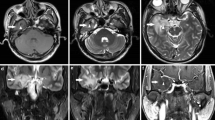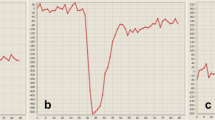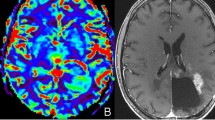Abstract
We examined nine patients with histologically proven nasopharyngeal carcinoma (NPC), treated with radiotherapy, using dynamic susceptibility contrast MRI (DSC-MRI). In eight there was clinical evidence of radionecrosis of the temporal lobe, and one was examined for local recurrence in the nasopharynx. All patients had either high-signal finger-like or cystic lesions in the temporal lobes on T2-weighted images. Heterogeneous contrast enhancement occurred in all patients. Relative regional cerebral blood volume (rrCBV) mapping revealed marked hypoperfusion in all patients. One underwent bilateral temporal lobectomy and radionecrosis was confirmed histologically.
Similar content being viewed by others
Author information
Authors and Affiliations
Additional information
Received: 19 November 1998/Accepted: 14 June 1999
Rights and permissions
About this article
Cite this article
Tsui, E., Chan, J., Leung, T. et al. Radionecrosis of the temporal lobe: dynamic susceptibility contrast MRI. Neuroradiology 42, 149–152 (2000). https://doi.org/10.1007/s002340050036
Issue Date:
DOI: https://doi.org/10.1007/s002340050036




